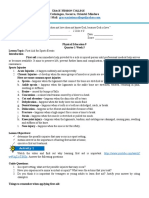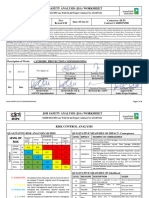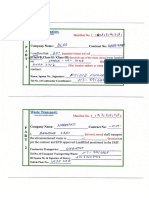0 ratings0% found this document useful (0 votes)
22 viewsDlps-Ompp Heat Stress Response Team
Dlps-Ompp Heat Stress Response Team
Uploaded by
DLPS HSEThis document provides contact information for members of an emergency response team for heat stress. It lists the team leader and members, along with their contact numbers. It then provides instructions for treating heat exhaustion and heat stroke. For heat exhaustion, it advises moving the person to a cool place, removing unnecessary clothing, and giving them cool fluids and cooling their skin. For heat stroke, it stresses seeking emergency medical care and using cooling methods like cool water immersion, spraying, sponging, and applying ice packs until help arrives.
Copyright:
© All Rights Reserved
Available Formats
Download as PDF, TXT or read online from Scribd
Dlps-Ompp Heat Stress Response Team
Dlps-Ompp Heat Stress Response Team
Uploaded by
DLPS HSE0 ratings0% found this document useful (0 votes)
22 views1 pageThis document provides contact information for members of an emergency response team for heat stress. It lists the team leader and members, along with their contact numbers. It then provides instructions for treating heat exhaustion and heat stroke. For heat exhaustion, it advises moving the person to a cool place, removing unnecessary clothing, and giving them cool fluids and cooling their skin. For heat stroke, it stresses seeking emergency medical care and using cooling methods like cool water immersion, spraying, sponging, and applying ice packs until help arrives.
Original Title
Dlps-ompp Heat Stress Response Team
Copyright
© © All Rights Reserved
Available Formats
PDF, TXT or read online from Scribd
Share this document
Did you find this document useful?
Is this content inappropriate?
This document provides contact information for members of an emergency response team for heat stress. It lists the team leader and members, along with their contact numbers. It then provides instructions for treating heat exhaustion and heat stroke. For heat exhaustion, it advises moving the person to a cool place, removing unnecessary clothing, and giving them cool fluids and cooling their skin. For heat stroke, it stresses seeking emergency medical care and using cooling methods like cool water immersion, spraying, sponging, and applying ice packs until help arrives.
Copyright:
© All Rights Reserved
Available Formats
Download as PDF, TXT or read online from Scribd
Download as pdf or txt
0 ratings0% found this document useful (0 votes)
22 views1 pageDlps-Ompp Heat Stress Response Team
Dlps-Ompp Heat Stress Response Team
Uploaded by
DLPS HSEThis document provides contact information for members of an emergency response team for heat stress. It lists the team leader and members, along with their contact numbers. It then provides instructions for treating heat exhaustion and heat stroke. For heat exhaustion, it advises moving the person to a cool place, removing unnecessary clothing, and giving them cool fluids and cooling their skin. For heat stroke, it stresses seeking emergency medical care and using cooling methods like cool water immersion, spraying, sponging, and applying ice packs until help arrives.
Copyright:
© All Rights Reserved
Available Formats
Download as PDF, TXT or read online from Scribd
Download as pdf or txt
You are on page 1of 1
OMPP-HGUPD
HEAT STRESS
EMERGENCYRESPONSE TEAM
Team Leader
Jonathan Camba 0506237186
Team Members
MITLESH KUMAR SINGH (First Aider) 0558734608
Barish Khan (Member) 0566034498
Melencio Doronio (Member) 0506237186
Shabaaz Shaik (Member) 0507422634
Vibin Valsan (Member) 0508935617
If someone has HEAT EXHAUSTION, follow these 4 steps:
1. Move them to a cool place.
2. Remove all unnecessary clothing like a jacket or socks.
3. Get them to drink a sports or rehydration drink, or cool water.
4. Cool their skin – spray or sponge them with cool water and fan them.
For HEAT STROKE:
Seek emergency medical care.
1. Put the person in a cool tub of water or a cool shower.
2. Spray the person with a garden hose.
3. Sponge the person with cool water.
4. Fan the person while misting with cool water.
5. Place ice packs or cool wet towels on the neck, armpits and groin.
6. Cover the person with cool damp sheets.
You might also like
- Aramco Heat Index A4Document1 pageAramco Heat Index A4DLPS HSE50% (2)
- Lifesaving Rules BookletDocument20 pagesLifesaving Rules BookletDLPS HSENo ratings yet
- Osha Heat StressDocument4 pagesOsha Heat StressWahed Mn ElnasNo ratings yet
- Eighteen: Environmental EmergenciesDocument66 pagesEighteen: Environmental EmergenciesLiezel CauilanNo ratings yet
- Untitled 2Document1 pageUntitled 2عرش حیدرNo ratings yet
- Meeting 5Document2 pagesMeeting 5prabawayogiNo ratings yet
- P.E WK 5-6Document6 pagesP.E WK 5-6Jomar MendrosNo ratings yet
- Climate 031217Document26 pagesClimate 031217doctorshimaa147No ratings yet
- CWTS (Lesson 2) Basic Life SuportDocument19 pagesCWTS (Lesson 2) Basic Life SuportAshley Kezia LopezNo ratings yet
- Concepts of First AidDocument102 pagesConcepts of First AidDafchen Nio MahasolNo ratings yet
- Unintentional InjuriesDocument11 pagesUnintentional InjuriesFrance FabroaNo ratings yet
- CRAMPS and HYPHORTEMIA Report.Document13 pagesCRAMPS and HYPHORTEMIA Report.Venzes kurt GonnadNo ratings yet
- Heat Illness PreventionDocument1 pageHeat Illness Preventionhelensym3No ratings yet
- Lesson 5 Peh1Document12 pagesLesson 5 Peh1Heron LacanlaleNo ratings yet
- Heat and Cold Related EmergenciesDocument11 pagesHeat and Cold Related EmergenciesHesedh Jireh MartinNo ratings yet
- First AidDocument13 pagesFirst Aidsumitagupta1212No ratings yet
- Treatment: Recommended/Required Medical Action in Case of Heat IllnessDocument1 pageTreatment: Recommended/Required Medical Action in Case of Heat IllnessrjavillarNo ratings yet
- Chapter 6 Environmental Considerations - 230712 - 230650Document39 pagesChapter 6 Environmental Considerations - 230712 - 2306502021467014No ratings yet
- First Aid Is The Provision of Initial Care For An: Illness Injury Medical TreatmentDocument9 pagesFirst Aid Is The Provision of Initial Care For An: Illness Injury Medical TreatmentIsha SoodNo ratings yet
- Heat StressDocument15 pagesHeat StressPakde Putu HadiNo ratings yet
- Personal Safety Protocol During Moderate Vigorous Physical ActivitiesDocument23 pagesPersonal Safety Protocol During Moderate Vigorous Physical Activitiesbaldonadoraivenkhate6No ratings yet
- Hyperthermia & HypothermiaDocument15 pagesHyperthermia & Hypothermiaseliena galapinNo ratings yet
- Lesson 12 RECOGNIZE AND GIVE FIRST AID FOR HEAT INJURIESDocument16 pagesLesson 12 RECOGNIZE AND GIVE FIRST AID FOR HEAT INJURIESsrtmedicNo ratings yet
- FIRST AID AND WATER SURVIVAL FinalDocument15 pagesFIRST AID AND WATER SURVIVAL FinalJaydine DavisNo ratings yet
- Importance of First AidDocument20 pagesImportance of First AidHeroe SedicoNo ratings yet
- Q3 First Aid For Common Unintentional InjuriesDocument43 pagesQ3 First Aid For Common Unintentional Injuriesbonitdanilo1968No ratings yet
- Heat StressDocument23 pagesHeat Stressdesh toyotatagumNo ratings yet
- Disease Prevention and Personal Hygiene Health 9th GradeDocument20 pagesDisease Prevention and Personal Hygiene Health 9th Gradeharucodm210No ratings yet
- Chapter 6 Environmental ConsiderationsDocument37 pagesChapter 6 Environmental ConsiderationsfazzrullshaikNo ratings yet
- Philippine Central Islands College: Quarter 4Document9 pagesPhilippine Central Islands College: Quarter 4Quijano, Stephanie L.No ratings yet
- Hope 4 Q4 M3 4Document8 pagesHope 4 Q4 M3 4Ara,cristline BabatuanNo ratings yet
- Unit 7 P.E NotesDocument4 pagesUnit 7 P.E NotesYusuf AbbasiNo ratings yet
- Peh4 5 ADocument4 pagesPeh4 5 Awilmer.directoNo ratings yet
- First aidDocument25 pagesFirst aidfloNo ratings yet
- Heat StrokeDocument2 pagesHeat StrokeshydlNo ratings yet
- Heat StrokeDocument2 pagesHeat StrokeshydlNo ratings yet
- Reviewer G12 Peh3Document27 pagesReviewer G12 Peh3Angel CañebaNo ratings yet
- Stroke NSTP ReportDocument22 pagesStroke NSTP ReportMenard NavaNo ratings yet
- 15-Temperature-Related-InjuriesDocument35 pages15-Temperature-Related-InjuriesKhirsten kaycee MillerNo ratings yet
- Personal Safety Protocol During Moderate Vigorous Physical ActivitiesDocument22 pagesPersonal Safety Protocol During Moderate Vigorous Physical Activitiesbaldonadoraivenkhate6No ratings yet
- Hope 2 - Sports Injury ManagementDocument36 pagesHope 2 - Sports Injury ManagementKenn AlmazanNo ratings yet
- Heat StressDocument11 pagesHeat Stressrigsme032No ratings yet
- Hypothermia, A Simple Guide To The Condition, Treatment And Related ConditionsFrom EverandHypothermia, A Simple Guide To The Condition, Treatment And Related ConditionsNo ratings yet
- First Aid Pocket GuideDocument24 pagesFirst Aid Pocket GuideHarsh Chadda75% (4)
- Heat Stroke Notes - OdtDocument4 pagesHeat Stroke Notes - Odtma mona liza sorianoNo ratings yet
- Survival SkillsDocument9 pagesSurvival SkillsNeha BalyanNo ratings yet
- Combat Life Saver: Lesson 12 Recognize and Give First Aid For Heat InjuriesDocument16 pagesCombat Life Saver: Lesson 12 Recognize and Give First Aid For Heat InjuriesMark CheneyNo ratings yet
- Safety TipsDocument16 pagesSafety TipsAnonymous do9rmemPDNo ratings yet
- Heat Stress PreventionDocument26 pagesHeat Stress PreventionSameer Omar100% (1)
- 15 First AidDocument65 pages15 First AidLovely De AyalaNo ratings yet
- Lesson On First AidDocument4 pagesLesson On First AidNoelNo ratings yet
- TWRP Weekly Safety Buzz - Issue 4 May 2023Document3 pagesTWRP Weekly Safety Buzz - Issue 4 May 2023Saiful IslamNo ratings yet
- Symptoms of Heatstroke or SunstrokeDocument2 pagesSymptoms of Heatstroke or Sunstrokekishoresahu3No ratings yet
- BLS Part 1Document29 pagesBLS Part 1miguelbreana02No ratings yet
- L16 Heat EmergenciesDocument5 pagesL16 Heat Emergenciesزيد السريحيNo ratings yet
- Chapter 18Document84 pagesChapter 18api-3743202100% (2)
- FrostbiteDocument13 pagesFrostbiteRosalyn YuNo ratings yet
- Heat Injury #6Document21 pagesHeat Injury #6NAOME VASQUEZNo ratings yet
- Illness and Injury: Medical EmergenciesDocument23 pagesIllness and Injury: Medical EmergenciesbrentupdegraffNo ratings yet
- Heat Stress Vs Heat StrokeDocument2 pagesHeat Stress Vs Heat Strokealigul649089No ratings yet
- Pe1 2 Las Q2 Week 1Document9 pagesPe1 2 Las Q2 Week 1shanalaina5No ratings yet
- The Cold Water Therapy Book: A Comprehensive Guide to Cold Water Immersion, Ice Baths, and Showers for Improved Health, Recovery, Mental Resilience, Sleep Quality, and Enhanced Immune System: Cold Exposure MasteryFrom EverandThe Cold Water Therapy Book: A Comprehensive Guide to Cold Water Immersion, Ice Baths, and Showers for Improved Health, Recovery, Mental Resilience, Sleep Quality, and Enhanced Immune System: Cold Exposure MasteryNo ratings yet
- Hazardous SubstancesDocument1 pageHazardous SubstancesDLPS HSENo ratings yet
- 1 - Chemical Hazards & Their Adverse Health Effects March 2024Document28 pages1 - Chemical Hazards & Their Adverse Health Effects March 2024DLPS HSENo ratings yet
- JSA-Tie-In of Spool To Existing NJYN 94-30Document8 pagesJSA-Tie-In of Spool To Existing NJYN 94-30DLPS HSENo ratings yet
- JSA-Plate Tagging Use of Cordless Drill-2316Document6 pagesJSA-Plate Tagging Use of Cordless Drill-2316DLPS HSENo ratings yet
- JSA-Cathodic Protection Commissioning-HRDH 2316Document6 pagesJSA-Cathodic Protection Commissioning-HRDH 2316DLPS HSENo ratings yet
- SCBA Pre-Use InspectionDocument2 pagesSCBA Pre-Use InspectionDLPS HSE100% (1)
- HEAT STRESS LogDocument1 pageHEAT STRESS LogDLPS HSENo ratings yet
- 3 - Hazard Communication - GHS Labels and SDSDocument63 pages3 - Hazard Communication - GHS Labels and SDSDLPS HSENo ratings yet
- 1.21 Safety Observation & Nearmiss ReportingDocument2 pages1.21 Safety Observation & Nearmiss ReportingDLPS HSENo ratings yet
- Aramco HSE ExamDocument66 pagesAramco HSE ExamDLPS HSENo ratings yet
- 5s ArabicDocument1 page5s ArabicDLPS HSENo ratings yet
- JSA For Cold Cutting J Hot Cutting J Loading and Unloading-Rev-00Document9 pagesJSA For Cold Cutting J Hot Cutting J Loading and Unloading-Rev-00DLPS HSENo ratings yet
- Attachment J - Rakkah Camp 7 - Feb-2021Document72 pagesAttachment J - Rakkah Camp 7 - Feb-2021DLPS HSENo ratings yet
- Dlps Equipment Inspection StickerDocument1 pageDlps Equipment Inspection StickerDLPS HSENo ratings yet
- Waste Manifest - DLPS-OMPPDocument2 pagesWaste Manifest - DLPS-OMPPDLPS HSENo ratings yet
- Extranet User Access Request Form (SA 8205-5)Document2 pagesExtranet User Access Request Form (SA 8205-5)DLPS HSENo ratings yet
- Heavy Equipment Pre Insp (EctionDocument1 pageHeavy Equipment Pre Insp (EctionDLPS HSENo ratings yet
- PMRF 012020Document2 pagesPMRF 012020DLPS HSENo ratings yet
- Chemical Storage & Handling SafetyDocument2 pagesChemical Storage & Handling SafetyDLPS HSENo ratings yet
- 14 Near Miss Reporting ProcessDocument8 pages14 Near Miss Reporting ProcessDLPS HSENo ratings yet
- Blaster Medical ReportDocument2 pagesBlaster Medical ReportDLPS HSENo ratings yet
- Internal Permit FormsDocument6 pagesInternal Permit FormsDLPS HSENo ratings yet
- HE Daily Inspection ExistingDocument1 pageHE Daily Inspection ExistingDLPS HSENo ratings yet
- Safety Gap Analysis Report ExampleDocument142 pagesSafety Gap Analysis Report ExampleDLPS HSENo ratings yet
- AssemblyDocument1 pageAssemblyDLPS HSENo ratings yet






















































































